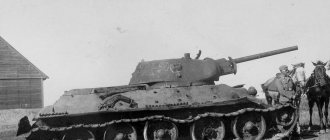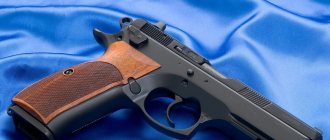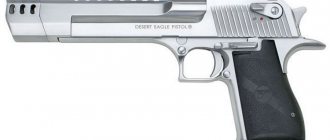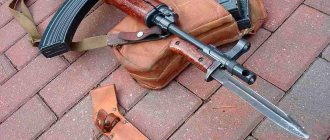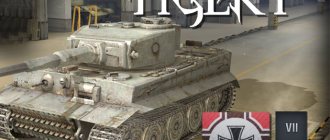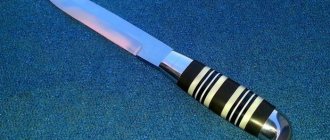Among the many weapons used during World War II, rifles deserve special attention. Operating rifles does not require as much training as, for example, driving a tank or piloting an airplane, and even women or completely inexperienced fighters can easily handle them. The relatively small size and ease of operation have made rifles one of the most widespread and popular weapons for warfare.
M1 Garand (Em-One Garand)
The Em-One Garand was the standard US Army infantry rifle from 1936 to 1959. The semi-automatic rifle, which General George S. Patton called “the greatest weapon of war ever created,” gave the American army a huge advantage in World War II.
While the German, Italian and Japanese armies still issued bolt-action rifles to their infantry, the M1 was semi-automatic and highly accurate. This caused the popular Japanese strategy of "desperate attack" to become much less effective, as they were now faced with an enemy that fired quickly and without missing. The M1 was also available with add-ons such as a bayonet or grenade launcher.
Lee Enfield
The British Lee-Enfield No. 4 MK became the main infantry rifle of the British and Allied armies. By 1941, when mass production and use of the Lee-Enfield began, the rifle had undergone a number of changes and modifications to the bolt action mechanism, the original version of which was created back in 1895. Some units (such as the Bangladesh Police) still use the Lee-Enfield, making it the only bolt action rifle in service for such a long time. In total, there are 17 million Lee-Enfield products of various series and modifications.
The Lee-Enfield has a similar rate of fire to the Em-One Garand. The sighting slit of the sight was designed in such a way that the projectile could hit the target from a distance of 180-1200 meters, which significantly increased the firing range and accuracy. Lee-Enfield fired 303 British cartridges with a caliber of 7.9 mm and fired up to 10 shots at a time in two bursts of 5 rounds.
First of all, of course, the Mauser 98K carbine comes to mind.
0
Caliber 7.92×57 mm, manual reloading, 5-round magazine, sighting range – up to 2000 m, so it was widely used with optical sights. The design turned out to be very successful, and after the war, Mausers became a popular base for hunting and sporting weapons. Although the carbine is a remake of a rifle from the end of the previous century, the Wehrmacht began to arm itself with these carbines en masse only in 1935.
Colt 1911 (Colt 1911)
The Colt is undoubtedly one of the most popular pistols of all time. It was Colt who set the quality bar for all pistols of the twentieth century.
The standard weapon of the US Armed Forces from 1911 to 1986, the Colt 1911 has been modified for use today.
The Colt 1911 was developed by John Moses Browning during the Philippine-American War because troops needed a weapon with high stopping power. The Colt 45 caliber coped with this task perfectly. It was a reliable and powerful weapon for the US infantry during World War II.
The first Colt, Colt Paterson, was created and patented by Samuel Colt in 1835. It was a six-shot revolver with a cap action. By the time John Browning designed his famous Colt 1911, Colt's Manufacturing Company was producing at least 17 Colt models. At first these were single-action revolvers, then double-action revolvers, and starting in 1900 the company began producing pistols. All the predecessor pistols of the Colt 1911 were small in size, relatively low in power, and were intended for concealed carry, for which they were nicknamed “vest pistols.” Our hero won the hearts of many generations - he was reliable, accurate, heavy, looked impressive and turned out to be the longest-lived weapon in the United States, serving faithfully in the military and police until the 1980s.
German MP-40
Contrary to the established myth, gunsmith Hugo Schmeisser had nothing to do with the production of the most popular PP material - the 9-mm Maschinen-Pistole 1940. It was developed by Heinrich Vollmer.
At close range, the MP-40, due to its larger caliber, had higher destructive power than the PPSh. It was also distinguished by its high reliability in shooting. The inconvenience was the strong heating of the barrel when firing, which is why you had to use gloves in battle (in films you often see soldiers supposedly holding a machine gun by the box magazine, which is actually prohibited by any instructions). Another drawback was the lack of switching to single shots.
Contrary to another myth, the MP-40 was not at all the main weapon of the German infantry. Only soldiers of motorized infantry units were armed with them. Not only in the USSR, but also in many other countries, in particular in Germany, the leadership for a long time could not get rid of prejudice against automatic small arms. Hitler considered the Mauser carbine from the First World War to be the best infantry weapon. During the Second World War, factories of the Third Reich produced only about one million PP of all types.
See also: What happened to the Germans who were captured at Stalingrad
Shpagin submachine gun
The Shpagin submachine gun (PPSh-41) is a Soviet-made assault rifle used both during and after World War II. Made primarily from stamped sheet metal and wood, the Shpagin submachine gun was produced in quantities of up to 3,000 daily.
The Shpagin submachine gun replaced the earlier version of the Degtyarev submachine gun (PPD-40), being a cheaper and more modern modification. "Shpagin" fired up to 1000 rounds per minute and was equipped with an automatic loader with 71 rounds. With the advent of the Shpagin submachine gun, the firepower of the USSR increased significantly.
Submachine gun STEN (STEN)
The British STEN submachine gun was developed and created in conditions of a massive shortage of weapons and an urgent need for combat units. Having lost huge quantities of weapons during the Dunkerque operation and facing the constant threat of a German invasion, the United Kingdom needed strong infantry firepower at short notice and at low cost.
STEN was perfect for this role. The design was simple, and assembly could be carried out in almost all factories in England. Due to the lack of funding and the difficult conditions in which it was created, the model turned out to be crude, and the military often complained about misfires. However, it was the boost to arms production that Britain so desperately needed. STEN was so simple in design that many countries and guerrilla forces quickly mastered its production and began producing their own models. Among them were members of the Polish resistance - the number of STENs they produced reached 2000.
Schwerer Gustav
The Great Gustav was the largest and most powerful cannon in history! It was developed by 'and, along with the Dora, was the heaviest railway weapon. "Gustav" weighed 1350 tons and could throw a charge over a distance of 45 kilometers. Can you imagine what a 7-ton charge looks like? It is very big!
So why didn’t the Allies surrender immediately as soon as they saw this huge machine? Well, now think : railway weapons. It required 2,500 soldiers to operate it, and it took 2 days to deliver it to the rails. It could only be transported disassembled and then assembled again. And a simple recharge took half an hour! The Gustav was also accompanied by several Luftwaffe aircraft to protect it.
The only time this machine actually helped the Germans was the siege of Sevastopol in 1942. This behemoth was a technical marvel, but completely impractical. "Gustav" and "Dora" dpjhdfkb in 1945 to prevent them from falling into Allied hands. But the Soviet armed forces were able to restore it and the giant weapon went to the Soviet Union.
Thompson submachine gun
During World War II, the United States produced more than 1.5 million Thompson submachine guns. The Thompson, which would later become known as the weapon of choice for American gangsters, was highly prized during the war for its effectiveness in close combat, especially among paratroopers.
The mass production model for the US Army beginning in 1942 was the M1A1 carbine, which was a simpler, cheaper version of the Thompson.
Equipped with a 30-round magazine, the Thompson fired .45 caliber cartridges, very popular in the United States at the time, and exhibited excellent stopping characteristics.
PPSh-41, also widely known thanks to cinema.
0
Caliber 7.62×25 mm, rate of fire: 900 rounds/min, effective range: 200 meters (sighting range – 300, which is important for single-shot shooting). The PPSh inherited a 71-round drum magazine, and later received a more reliable open-arm magazine with 35 rounds. The design was based on stamping-welded technology, which made it possible to mass produce the product even in harsh military conditions, and in total about 5.5 million PPSh were produced during the war years. Main advantages: high effective firing range in its class, simplicity and low cost of production. Disadvantages include significant weight, as well as too high rate of fire, which leads to excessive consumption of ammunition.
Bren light machine gun
The Bren light machine gun was a powerful, easy-to-use weapon that could always be relied upon, and was the main weapon for British infantry platoons. A licensed British modification of the Czechoslovak ZB-26, the Bren was introduced into the British Army as the main light machine gun, three per platoon, one for each rifle station.
Any problem that arose with Bren could be solved by the soldier himself by simply adjusting the gas spring. Designed for the 303 British cartridge used at Lee-Enfield, the Bren was fitted with a 30-round magazine and fired 500-520 rounds per minute. Both Bren and his Czechoslovakian predecessor are very popular today.
Let's move on to Soviet weapons of that time.
Let's start, of course, with the glorious Mosin rifle of the 1891-30 model, and, of course, the carbine of the 1938 and 1944 model.
0
Caliber 7.62×54 mm, manual reloading, magazine for 5 rounds, sighting range - up to 2000 m. The main small arms of the Red Army infantry units of the first period of the war. Durability, reliability and unpretentiousness have entered legends and folklore. The disadvantages include: a bayonet, which, due to an outdated design, had to be carried permanently attached to the rifle, a horizontal bolt handle (that’s realistic - why not bend it down?), inconvenient reloading and a safety lock.
0
Browning M1918
The Browning M1918 Automatic Rifle was a light machine gun in service with the US Army in 1938 and was used until the Vietnam War. Even though the US never set out to develop a practical and powerful light machine gun like the British Bren or the German MG34, the Browning was still a worthy model.
Weighing between 6 and 11 kg and chambered in .30-06 caliber, the Browning was originally intended as a support weapon. But when American troops faced heavily armed Germans, tactics had to be changed: for each rifle squad, at least two Brownings were now given, which were the main elements of the tactical decision.
Finnish "Suomi"
Before World War II, the military of all major powers disdained SMGs as a class of small arms. A breakthrough in this regard was made by a small country - Finland. During the Winter War 1939-1940. Finnish troops inflicted terrible losses on the Red Army thanks to the 9-mm Suomi machine guns of the 1931 model.
"Suomi", created by designer Lahti, had a disk magazine with 69 rounds of ammunition and a mechanism for switching fire between bursts and single shots. It was very resistant to low temperatures. The successful use of these weapons by the Finns forced the Soviet leadership to reconsider their negative attitude towards submachine guns.
Already in 1940, the Degtyarev PP, created in the image and likeness of the Suomi, was adopted into service by the Red Army, with modifications for the standard Soviet 7.62 mm cartridge. A disk magazine was also taken from the prototype, which could hold two more rounds. The captured Suomi spawned a whole family of Soviet SMGs, very similar to the original.
Single MG34 machine gun
The MG34 single machine gun was one of the weapons that made up Germany's military might. One of the most reliable and high-quality machine guns of World War II, the MG34 had an unsurpassed rate of fire - up to 900 rounds per minute. It was also equipped with a double trigger, which made both semi-automatic and automatic firing possible.
StG 44 assault rifle
The StG 44 was developed in Nazi Germany in the early 1940s and mass production began in 1944.
The StG 44 was one of the main weapons in the Wehrmacht's attempts to turn the war in its favor - factories of the Third Reich produced 425 thousand units of this weapon. The StG 44 became the first mass-produced assault rifle, and significantly influenced both the course of the war and the further production of weapons of this type. However, it still did not help the Nazis.
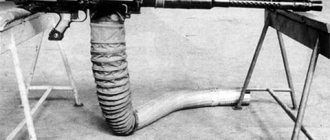
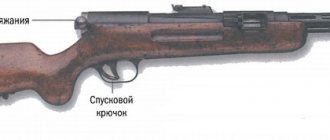
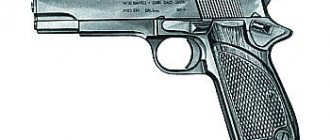
!['Domestic small arms [studio "Wings of Russia"] (2011)'](https://knifesburg.ru/wp-content/uploads/otechestvennoe-strelkovoe-oruzhie-studiya-krylya-rossii-2011-330x140.jpg)
